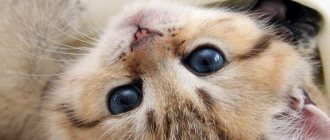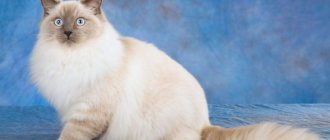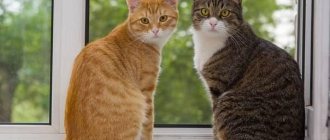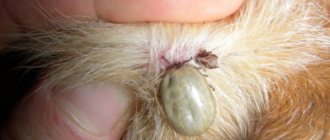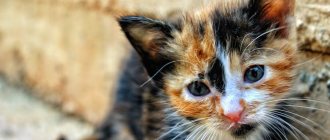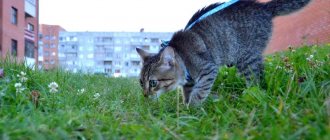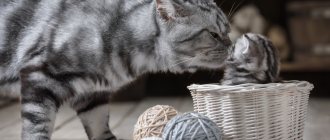With their appearance, Lyka cats created a sensation in the world of felinology. They are not the result of a genetic experiment, as one might think. Lykoi appeared as a result of natural mutations of a short-haired cat. In character and habits, they are no different from ordinary domestic purrs. Breeders claim that, despite its external resemblance to werewolves, the cat will definitely not begin to turn into a full moon.
- 6.1 Price
Origin story
Lykoi cats are not the result of a crazy experiment; they are the result of a natural mutation. In 2010, in Virginia, Patty Thomas discovered that his yard shorthair cat had given birth to unusual kittens; by the age of one month, they began to develop bald patches through which pink skin was visible. Tedious trips to veterinarians followed, taking various tests and searching for health problems. Meanwhile, the kittens grew up and developed completely normally. The specialists’ verdict was made - they are absolutely healthy. Thomas later became one of the founders of the breed, who gave it its name.
In 2011, Johnny Gobble in Tennessee discovered a second pair of animals with an identical mutation. Kittens from two litters were the basis of a program to increase the Lykoei gene pool, which also included ordinary black shorthair cats. During its formation and development, the breed underwent more DNA tests for various diseases than any other. According to information, similar mutations have occurred before, but no one thought about their preservation.
The name of the breed Lykoi was not chosen by chance. Translated from Greek, lykos means wolf or werewolf.
In 2011, the first kitten from a pair of Lykoi appeared. The breed began to develop at a rapid pace; after a few years, nurseries were opened in other States: Missouri, South Carolina, Texas, California. Werecats began to travel to different countries and continents. In 2012, they were accepted into the TICA registry of new breeds, and in 2020 they received champion status and the right to exhibit.
The creepy appearance not only does not interfere with these creatures, it is what contributes to the growth in popularity and demand for kittens, which is hundreds of times higher than the supply.
Video about cats of the Lykoi breed:
Why are cats hairless?
global $ads_google;
//data-ad-slot=”2475549904″ $ads_google = empty($ads_google) ? false : true; ?> if ($ads_google == false) {?> $ads_google = true; ?> } ?> The mentioned cats Nellie and Dick turned out to be relatives, which is probably why the owner did not breed the breed, although he gave the animals a detailed description.
By the middle of the 20th century, information about the appearance of kittens without fur began to appear in the media from different countries.
It is believed that a kitten named Prune from North America became the ancestor of the Canadian Sphynx. The Don Sphynx was registered in 1998; the wonderful cat Varvara is considered the ancestor. It became clear that new
horizons for breeding cats. They began to actively breed hairless cats after the 80s of the last century.
A mutation led to the appearance of bald purrs in the world - thanks to this genetic failure, which is hereditary, the world saw new breeds of cats.
Appearance
It's amazing how quickly a breed with such a shocking appearance became popular among cat lovers all over the world. Lykoi are partially hairless cats with a unique coloration that is a combination of black and white hairs. There is a noticeable difference between cats and cats, it is visible even in the photo. Males are noticeably larger and more massive, their weight usually ranges from 4.5-6 kg, while cats weigh 2-3.5 kg.
The Lykoei mutation is individual, which is confirmed by comparative DNA analysis with sphinxes and Devon rexes. The baldness gene in Lykoi is recessive. Another DNA analysis showed that their color is not a tabby variety.
The head is medium-sized, wedge-shaped. The stop is not expressed. The nose is wide, slightly humped. The neck is long. The ears are wide at the base, high, slightly pointed. The distance between the ears is not large. The eyes are round, expressive, color: yellow, gray, green or blue. The hairless muzzle gave the Lykoi the amazing, easily recognizable appearance of a werecat. The body is compact, not too powerful, but not thin either, athletic, slightly elongated and flexible with a wide chest. Legs of medium length, medium sized tail.
Bald areas are located around the eyes, on the virris pads, on the chin and on the bridge of the nose. Almost all representatives of the breed have sparse hair on the front and hind legs, chest and belly.
The coat of the Lykoi is very soft, short, and sparse. Consists only of guard hair, the undercoat is completely absent. The degree of baldness in cats varies from person to person; some may be practically naked, while others are distinguished only by their “moth-eaten” muzzle. Another distinctive feature is the original roan color or roan.
Among cats, it is found only in Lykoeis. The skin is pink and tans quickly in the sun, like other hairless breeds. The most popular color is black and white, a pronounced roan, but cats can also have lighter coats, up to light gray, which in combination with white hairs and hairless areas makes them very light.
Character
Lykoi are very smart and inventive cats, sociable, friendly, active and playful. They will play with people with pleasure, and in hours of solitude they will entertain themselves with a toy or any other little thing that attracts attention. They easily and happily walk outside and selflessly protect the territory. This behavior is especially pronounced in cats.
At home they are curious and very energetic. rarely sleep for 20 hours at a time, prefer to be in the center of events, will explore new toys and surroundings with interest, need close contact with a person and new impressions. At the first meeting, they behave carefully, carefully getting to know any new object, person or pet to make sure there is no danger or threat. Owners note that many Lykoys like to sit in the gopher pose and actively use their front legs in play and everyday life. Lykoys demonstrate strong hunting instincts during play; on the street they happily hunt beetles and butterflies; they rarely pursue larger prey.
Horoscope compatibility
According to the horoscope, Lykoy suits two zodiac signs: Sagittarius and Aquarius. This is due to the unusual appearance and character traits of the breed.
Since Sagittarians love everything exotic, they will certainly pay attention to Lykoi. The character of the animal also corresponds to the essence of the zodiac - a warrior on the outside and good-natured on the inside. Likoi is sociable, playful, has a developed intellect, and becomes not only an ally, but also a guard for the owner.
Aquarians are sociable, liked by others, and easily make new friends. Lykoi is a complete copy of this zodiac sign. The breed combines an extraordinary appearance with a high degree of affection for humans, which is compared to the devotion of a dog. Aquarius and Liko will be comfortable spending time together.
Despite the price and original appearance, the werewolf cat is becoming popular every year. People are willing to wait months for a pet to grow up in order to become the owner of a rare breed.
Content Features
Lykoi are perfectly suited for living in an apartment or in a house, they quickly adapt to new conditions, become attached to all family members, and are neat and clean. Contrary to popular belief, they are not hypoallergenic. Like other cats, they shed, the degree of shedding depends on the time of year, the amount of hair on the body and climate. The fur is very soft to the touch, the naked body is warm and velvety, and the nose, as expected, is cold and wet.
Lykoi are very friendly, so they easily get along with other pets, cats, dogs, small rodents and birds, anyone who doesn’t mind their company.
The effects of heat and cold on bare skin are more active than in coated cats. In the cold season, it is advisable for them to select clothes according to the weather, and in the summer to protect them from excess direct sunlight, which can cause burns. Given the high activity of the cat, it is advisable to install a play complex.
Care
Grooming is an important part of keeping a cat; it is not difficult since cats have little hair. For bathing, it is recommended to use a mild cat shampoo with a natural hypoallergenic base. The frequency of washing is individual in each case and depends on the skin type.
Some lykoys are washed once a month, others - once every six months.
Periodically comb the cat or remove mature hairs with a damp hand. Ears need to be cleaned regularly. A peculiarity of the breed is the accumulation of brown secretion from the sebaceous glands in the ear and near the claws, which must be carefully cleaned approximately once a week.
Nails should be trimmed regularly. Like Sphynxes, they have a brown secretion around their claws, which is rarely a sign of illness and can be easily removed.
Feeding
There are no special feeding recommendations. Like other cats, the Lykoi needs a balanced, healthy diet. Most breeders prefer wet or dry ready-made food.
Lykoyam diets are suitable for domestic cats of small and medium breeds. You should not pay attention to food below the super-premium class. If you wish, you can provide cats with complete natural nutrition, but this will be difficult, given that they are often picky eaters.
Health and life expectancy
The experience of breeders and multiple tests have shown that in the breed at this stage the hairlessness gene is not associated with any pathologies or hereditary diseases. Lykoys can have any feline health problems, but, as a rule, they are caused by improper care, maintenance or nutrition.
Likoi were tested for selective diseases of the skin, heart, thyroid gland, blood, some infectious diseases, as well as hereditary diseases of the kidneys, liver and digestive tract common among cats. All results are negative, which suggests good health and good genetics.
Lykoi cats need the same vaccinations as regular domestic cats, as well as regular treatment for external and internal parasites. Use standard veterinary products. The breeders claim that they have never observed an allergic reaction to veterinary drugs, food or cosmetics.
Where to buy a Lykoi kitten
Buying a Lykoi kitten is now easier than it was in the early years of their appearance, but the number of kittens on sale is still very limited. As of 2020, there are just over 200 standard Lykoi cats registered in the world with a characteristic color and location of receding hairline, as in the photo. Nurseries can be found not only in the States, but also abroad, in particular in Russia and neighboring countries. Some companies deliver kittens with documents directly from America.
Newborn kittens differ from adults in their uniform solid color, and they do not have bald patches.
With age, more and more white hairs appear and in some places the hair begins to fall out. By 1.5 months they acquire a practically formed roan color, which remains in the future.
Price
The average price of a Lykoi kitten in the United States is $2,000. Naturally, we are talking about kittens with documents of origin from nurseries. In European countries, the price fluctuates approximately in the same range. There are only a few representatives of the breed in Russia, most of them live in one of the largest Moscow nurseries, Murmulet. The price of a Lykoi kitten in Moscow usually starts from 100,000 rubles.
The limited number of kittens and huge demand allows breeders to keep the price at the same high level as their foreign colleagues. In addition, the cost of a kitten is affected by its color; dark-colored babies usually cost more. Those wishing to buy a kitten abroad need to be careful. In America, offers have already begun to appear from scammers or “swindlers” to sell lykoi inexpensively.
Buying Lykoi
Direct sale of kittens is carried out after they reach 3 months.
For purebred kittens, it is necessary to undergo registration in clubs of European or American systems (for Lykoi this is TICA), after which they receive a metric. This procedure must be carried out before selling the kitten: it guarantees the purity of the breed. Subsequently, the metric is exchanged for the pedigree.
Before selling, the breeder must give the kittens at least a primary vaccination, or preferably two at once.
Video: Likoy cat in a Russian nursery
Unfortunately, due to their small numbers and relative freshness of the breed, Lykoi are not easily accessible animals for purchase. The TICA website lists only two registered nurseries and they are located in the USA (Michigan and Oklahoma), and in Russia, according to breeders, only 4 nurseries have Lykoi. Therefore, having received an offer to sell a Lykoi, you should think about whether they are trying to sell the animal to you.
Distinctive features of Likoy breed kittens:
- black coat color;
- the presence of a bald mask on the face;
Some breeders compare Likoy kittens to monkeys because of the characteristic mask on their face.
- the presence of characteristic bald patches on the paws.
